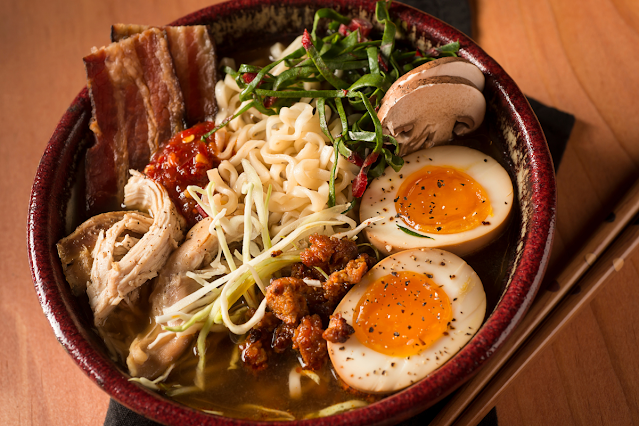Ramen Renaissance
How a humble noodle soup became a global indie food sensation.
Ramen, a quintessential Japanese noodle soup, has undergone a remarkable transformation. Originally a simple, affordable meal, it now stands as a gourmet phenomenon that has captivated foodies and indie culture enthusiasts worldwide. But how did this humble dish achieve such fame? In this blog post, we will explore the origins of ramen, its evolution into a culinary art form, and its impact on global culture.
The Origins of Ramen
Ramen's story begins in Japan, where it was introduced as a quick, inexpensive meal for laborers. It was a comforting bowl of wheat noodles served in a savory broth, often topped with slices of pork, green onions, and nori.
Ramen quickly became a staple in Japanese cuisine. During the post-World War II era, it provided a much-needed source of sustenance for a recovering nation. Street vendors sold ramen from small carts, and it became a symbol of resilience and community.
In 1958, Momofuku Ando revolutionized the world of ramen by inventing instant ramen. This innovation made it possible for people to enjoy a quick and delicious meal anytime, anywhere. Instant ramen became a global sensation, introducing the world to the flavors of Japan.
The Gourmet Transformation
Ramen's shift from a humble, quick meal to a gourmet dish is nothing short of extraordinary. Today, it is celebrated for its complexity and artistry.
Modern ramen chefs are akin to artists, meticulously crafting each bowl. They experiment with various broths, noodles, and toppings, creating unique flavor profiles that elevate ramen to an art form. Whether it's a rich tonkotsu broth or a delicate shoyu base, every element is carefully considered.
Ramen has become a canvas for culinary innovation. Chefs worldwide have embraced the dish, infusing it with their creativity. From truffle oil to sous-vide eggs, gourmet ingredients have found their way into ramen bowls, pushing the boundaries of traditional flavors.
The Rise of Ramen Restaurants
Specialty ramen restaurants have sprung up in major cities across the globe. These establishments often feature open kitchens, allowing diners to witness the craftsmanship that goes into each bowl. The experience extends beyond the food itself, creating an immersive dining adventure.
Exploring Ramen Variations
Ramen's versatility is one of its greatest strengths. There are countless variations to explore, each offering a unique culinary experience.
Traditional Styles
Traditional ramen styles like miso, shio, and shoyu remain popular. Miso ramen, with its hearty and umami-rich broth, is a comforting choice. Shio ramen, known for its clear and delicate broth, offers a lighter option. Shoyu ramen, with its soy sauce-based broth, strikes a balance between richness and subtlety.
Fusion Creations
The fusion movement has brought exciting new twists to ramen. Chefs experiment with flavors from different cuisines, creating fusion ramen dishes that delight the palate. Thai-inspired ramen with coconut milk and lemongrass or Mexican ramen with spicy chorizo are just a few examples of this trend.
Vegan and Vegetarian Options
In response to changing dietary preferences, vegan and vegetarian ramen options have gained popularity. These bowls feature innovative plant-based broths and toppings like tofu, mushrooms, and seasonal vegetables. They prove that ramen can be both delicious and sustainable.
easy miso ramen recipe
Ramen Shops as Cultural Hubs
Ramen shops have evolved into more than just places to eat; they are cultural hubs that foster community and culinary exploration.
These ramen shops often host events like ramen tastings, cooking classes, and chef collaborations. They encourage patrons to explore the nuances of different ramen styles and ingredients, fostering a deeper appreciation for the dish.
Ramen shops provide a sense of community. Patrons bond over their shared love for ramen, creating a welcoming atmosphere where friendships are formed. The communal dining experience, often at long, shared tables, enhances this sense of togetherness.
Many ramen shops integrate art and culture into their spaces. Walls adorned with local artwork, live music performances, and themed decor create a vibrant and dynamic environment. These elements celebrate the intersection of food, art, and culture, making each visit a memorable experience.
The Future of Ramen
Ramen's future is bright, with exciting trends and innovations on the horizon.
The fusion trend will continue to thrive, with chefs from diverse backgrounds contributing their unique perspectives to ramen. Expect to see more cross-cultural collaborations that result in inventive and flavorful creations.
Sustainability will play a significant role in the future of ramen. Chefs will prioritize locally sourced ingredients, reducing their carbon footprint. Plant-based ramen options will become more prevalent, catering to environmentally conscious diners.
Technology will also shape the future of ramen. Automated ramen-making machines and AI-driven kitchen assistants will streamline the preparation process, ensuring consistency and efficiency. However, the human touch and artistry will remain essential in crafting the perfect bowl.
From humble beginnings to global sensation
Ramen's journey from a humble noodle soup to a global culinary sensation is a testament to its versatility and cultural impact. Its ability to adapt and innovate while staying true to its roots has endeared it to foodies, culinary explorers, and indie culture enthusiasts alike.
Whether you savor a traditional bowl of shoyu ramen or indulge in a fusion creation, ramen offers something for everyone. It brings people together, fosters community, and celebrates the art of culinary craftsmanship.
Ready to join the ramen renaissance? Explore your local ramen shops, experiment with different styles, and immerse yourself in the rich and flavorful world of ramen. Your next culinary adventure awaits!





Comments
Post a Comment